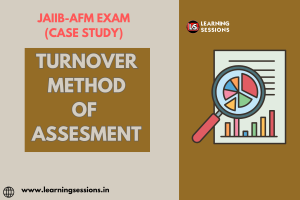For banking professionals preparing for the Junior Associate of Indian Institute of Bankers (JAIIB) exam, a deep understanding of the Turnover Method of Assessment is essential. This topic, covered in the Accounting and Financial Management (AFM) module, is necessary for understanding how creditworthiness and loan eligibility are assessed for businesses, especially small and medium enterprises (SMEs). The turnover method serves as a practical approach to determining working capital requirements based on projected sales turnover. Learning Sessions will take you through this article on the case study exploring the Turnover Method of Assessment, its application, key principles, and relevance in the JAIIB AFM module.

📚 JAIIB Study Resources 📚
👉 Check Here
👉 Check Here
👉 Check Here
👉 Get Tests Here
👉 Check Here
DOWNLOAD PDF TURNOVER METHOD OF ASSESMENT -CASE STUDY
The Turnover Method of Assessment is a working capital financing technique where a bank assesses a business’s credit needs based on its annual sales turnover. Developed by the Reserve Bank of India (RBI), this method is specifically applied to small and medium-sized enterprises that may lack the comprehensive financial statements typically required for traditional assessment methods. This method assumes that a portion of the sales turnover is sufficient to cover the working capital needs of a business.
For the extensive preparation of candidates, get details through our YouTube videos for JAIIB AFM Module wise Syllabus with explanations and tips to help candidates in their preparation journey.
You may also like these JAIIB case studies:
JAIIB | AFM | RISK BASED INTERNAL AUDIT
JAIIB | AFM | SUBSIDIARY BOOK
In the JAIIB AFM module, the Turnover Method is essential for several reasons:
- Simplifies Loan Assessment for SMEs:
- Promotes Financial Inclusion:
- Ensures Adequate Working Capital:
The turnover method typically involves estimating the working capital requirement as a percentage of projected turnover, using a formula set by the RBI. Here is a basic framework for how it works:
- Estimating Sales Turnover
- Applying a Margin Percentage
- Determining Working Capital Limit
- Periodic Review and Adjustment
Overall it may be said, In the JAIIB AFM module, the Turnover Method of Assessment is an essential tool for assessing working capital needs of businesses, particularly for SMEs. By relying on sales turnover as a basis for working capital, this method simplifies credit assessment, promotes financial inclusion, and supports business growth. Learning Sessions provides additional information about JAIIB AFM OVERDRAFT BALALNCE by giving examples of real life scenarios.
Learn more about this case study through our YouTube channel and PDF.
Get access to our Telegram Channel for free Pdfs of JAIIB.
You May also Find these JAIIB Posts Useful
TYPES OF FINANCIAL DERIVATIVES PRODUCTS
REGULATION OF DERIVATIVE MARKET







